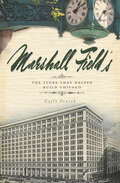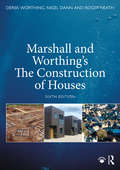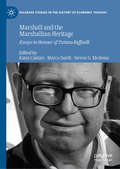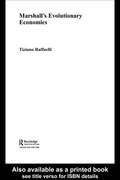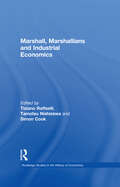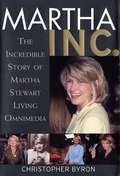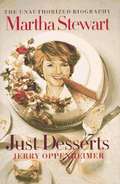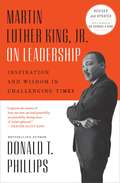- Table View
- List View
Marshall & Gordon: Designing an Effective Compensation System (B)
by Kerry Herman Heidi K. GardnerCEO Kelly Browne wrestles with the design and roll-out of a new compensation system to promote the collaboration necessary for supporting her firm's new strategy. Marshall Gordon International, a global public relations (PR) firm, has recently expanded its service offering to include Executive Positioning, which requires significantly more teamwork, higher-level client interaction and more strategically-minded consultants than their traditional PR work. This "B" case focuses on the choices the firm needs to make about roll-out, including how to measure aspects of consultants' performance, what performance management systems and processes need to support the compensation system, and who should have decision rights about consultants' variable compensation.
Marshall Field's: The Store that Helped Build Chicago (Landmarks)
by Gayle SoucekA history of the iconic department store and a city&’s life over a century and a half.Anyone who has waited in a Christmas line for the Walnut Room&’s Great Tree can attest that Chicago&’s loyalty to Marshall Field&’s is fierce. Dayton-Hudson even had to take out advertising around town to apologize for changing the Field's hallowed green bags. And with good reason—the store and those who ran it shaped the city's streets, subsidized its culture, and heralded its progress. The resulting commercial empire dictated wholesale trade terms in Calcutta and sponsored towns in North Carolina, but its essence was always Chicago. So when the Marshall Field name was retired in 2006 after the stores were purchased by Macy&’s, protest slogans like &“Field&’s is Chicago&” and &“Field&’s: as Chicago as it gets&” weren't just emotional hype. Many still hope that name will be resurrected like the city it helped support during the Great Fire and the Great Depression. Until then, fans of Marshall Field&’s can celebrate its history with this warm look back at the beloved institution.</
Marshall Industries
by Jeffrey F. Rayport Cathy OlofsonConfounding predictions that the Internet would "disintermediate" commerce, making "middle man" companies all but obsolete, Marshall Industries, a leading electronics distributor, used the Internet and digital technologies to reinvent itself. Marshall continued to sell electronics components, but the company abandoned the traditional sales-driven strategy for a more customer-focused, service-driven strategy. At the heart of its transformation was a complete restructuring of the compensation and incentive system and heavy investments in information technologies. Several years into its first foray into the digital realm, Marshall faced growing pressures: shrinking margins, increasingly demanding customers, restrictive supplier practices, and competitors rapidly introducing me-too Internet and virtual services. Marshall continued to look for ways to use its innovative spirit and digital expertise to differentiate itself and to create and deliver a whole new set of virtual supply chain services.
Marshall Plan Days (Routledge Revivals)
by Charles P. KindlebergerOriginally published in 1987 to commemorate the 40th anniversary of the Marshall Plan, this fascinating collection of essays, from an eminent ‘insider’ to the Marshall Plan, combines economics, politics and history to provide authoritative and personal insights into the creation of one of the greatest foreign aid programmes of the twentieth century. Any reader interested in the Marshall Plan itself, the inner workings of a major act of US foreign policy, and its many economic, political and historical facets will welcome the reissue of this valuable book from one of America’s most distinguished economists.
Marshall and Worthing's The Construction of Houses
by Derek Worthing Duncan Marshall Roger Heath Nigel DannThe sixth edition of The Construction of Houses builds on the success of the previous five editions. The book provides a comprehensive introduction to the principles and processes of the construction of houses and their services. As such it is aimed at providing a broad understanding of domestic building construction for students as part of their academic studies and as a useful information source for practitioners. The existing chapters have all been updated and most of them expanded to take account of changes to dwelling house construction since the last edition and there are new chapters on ‘Modern Methods of Construction’ and ‘Regulatory controls and building standards’. Additionally, many new and/or updated photographs and diagrams have been added. As with the previous editions, the authors have concentrated on presenting current mainstream approaches to the construction of houses. The detailed, yet accessible, text that is supported by hundreds of coloured photographs and diagrams provides clear explanations of the many complex processes that go into the building of a house. A deeper insight into modern construction is also given by the book’s consideration of historical building techniques from the 18th century onwards in order to illustrate how and why we build houses in the way we do now.
Marshall and the Marshallian Heritage: Essays in Honour of Tiziano Raffaelli (Palgrave Studies in the History of Economic Thought)
by Steven G. Medema Katia Caldari Marco DardiTiziano Raffaelli (Pisa 1950) was a widely esteemed scholar in the field of the history and methodology of economics, who died suddenly in January 2016 while still in the midst of working and of developing projects for new lines of research. He was a philosopher of science by formation and a historian of economic ideas by professional choice, with interests covering a vast area, ranging from the 18th to the 20th century and from Europe to the US. Where he left an indelible mark, however, was in his interpretation of Alfred Marshall’s economic theory and its reverberations through Keynes on the one hand, and the Cambridge school of industrial economics on the other. Raffaelli’s research in this field offered a completely new view of the core and meaning of Marshall’s work and of its relevance for 21st century social scientists. In the process, it stimulated a new and fruitful research program in Marshallian economics.This volume consists of two parts. The first is devoted to illustrating the above-mentioned changes in the understanding of Marshallian economics and Raffaelli’s role in bringing them about. The second part offers a collection of essays documenting some more recent developments in fields related to Marshall and his influence, including welfare economics and industrial organization, Marshall’s legacy in Cambridge economics, the Chicago school, and beyond. The contributors to this volume range from leading senior scholars in the field to exceptional young scholars, and their contributions illustrates a myriad of ways in which the “new view” of Marshall inspired by Raffaelli’s work influences our understanding of the history of economics from the late 19th century onward. This book will be of international interest to scholars working in the history of economic thought, and will also appeal to philosophers of science, methodologists, intellectual historians, and those who specialize in industrial organisation.
Marshall's Evolutionary Economics (Routledge Studies in the History of Economics #Vol. 59)
by Tiziano RaffaelliAlfred Marshall was one of the most important economists ever to have lived. This excellent new book, from a Marshall expert respected the world over, attempts to show that Marshall anticipated some of the views that are now associated with the cognitive sciences. Examining Marshall's philosophy of the human mind, his overall approach to economics, his concern for socio-economic issues, and the fertility of his framework, this book breathes fresh life into the fascinating world of Marshallian economics.
Marshall, Marshallians and Industrial Economics (Routledge Studies In The History Of Economics Ser.)
by Tiziano Raffaelli Tamotsu Nishizawa Simon CookThe four sections of the book deal in succession with Marshall’s key ideas on the subject, the wider context of his thought in which they are to be read, their later development by some of his pupils, and their revival in contemporary economics. The first and last sections work together to illustrate the evolutionary focus of Marshall’s research program and to identify its affinity with modern industrial economics; the second explicates the social assumptions within which the Marshallian paradigm was embedded, in particular those relating to the various relationships that exist between individuals and wider groups; while the third traces the development of Marshall’s views by some of his pupils.
Martha Goldberg Aronson: Challenges at Mid-Career (B)
by William W. GeorgeMartha Goldberg Aronson of Medtronic is trying to decide whether to accept the offer from Medtronic CEO Bill Hawkins to become senior vice president and chief talent officer. Aronson returned from an executive role in Europe just 18 months before as vice president, investor relations, but sees herself as a fine executive. Thus, she is undecided about taking a senior staff position.
Martha Goldberg Aronson: Leadership Decisions at Mid-Career
by Andrew N. Mclean William W. GeorgeIn 2005, Martha Goldberg Aronson must decide whether to accept an overseas posting in a functional role with Medtronic Corp. The move would be a professional stretch, but would entail leaving a position with a plan half completed and moving her young family overseas. Profiles the youth, career, family life, aspirations, and motivations of the rising executive. Provides information about the practical, personal, and business challenges of an international assignment. Raises questions regarding work-life balance and the opportunities of the proposed stretch assignment in balance with the desire to see an existing process through to completion.
Martha Inc: The Incredible Story of Martha Stewart Living Omnimedia
by Christopher M. ByronMartha Stewart has generated an enormous following by establishing herself as the leading authority for all things domestic and in the process created a multimillion-dollar enterprise and a personal net worth of nearly $2 billion. As one of the most successful self-made female business owners in American history, Martha Stewart is a topic of interest for fans, business professionals and would-be entrepreneurs alike. Martha Inc. tells the compelling story of how this complex woman created an empire on domesticity and examines her business inside and out. Through an engaging narrative by popular columnist Christopher Byron, this book chronicles how the business was built, what it took to take it public, and the personal and professional transformation Martha has undergone to make it all work. To get a true portrait of the woman whose work ethic is her personal life, Byron delves into the underreported facets of Martha's past, such as the effects her challenging childhood and years on Wall Street have had on her uncompromising business acumen. From Martha Stewart Living magazine and marthastewart. com to a K-Mart line of houseware products, a line of house paints, and a television show, this book details how a former caterer from Connecticut has created a media and merchandising empire, pulling off what large media corporations with vast resources struggle to accomplish. Martha Stewart has sold America on good taste and now readers can learn exactly how she did it and what drives her to keep conquering new vistas. A corporate biography as well as a success story worthy of Horatio Alger, Martha Inc. also delves into how a cult of personality is created and how Martha Stewart capitalized on the zeitgeist that characterized the last half of the twentieth century. This book is a must read for anyone who has been touched by Martha's marketing savvy or who dreams of making it big.
Martha McCaskey
by Joshua D. Margolis Bart J. Van DisselMartha McCaskey, a project leader at a consulting firm, is asked to complete a project at a crucial point in her career. Successful completion of the project would gain McCaskey a promotion and a significant raise. McCaskey, however, cannot see a way to complete the project without compromising her values. She must decide whether to maintain the high degree of integrity that has always characterized her work or to compromise and "play the game."
Martha Rinaldi: Should She Stay or Should She Go?
by Linda A. Hill Mark RennellaMartha Rinaldi has been an assistant product manager at leading beverage company Potomac Waters since graduating from business school. Rinaldi is frustrated by her relationships with her boss and a close co-worker. Even though she works hard to please her manager, she has received a negative performance evaluation for her first four months. Should Rinaldi leave Potomac for a standing job offer at a company she previously interned with or try to improve her current situation?
Martha Rinaldi: Should She Stay or Should She Go?
by Linda A. Hill Mark RennellaMartha Rinaldi has been an assistant product manager at leading beverage company Potomac Waters since graduating from business school. Rinaldi is frustrated by her relationships with her boss and a close co-worker. Even though she works hard to please her manager, she has received a negative performance evaluation for her first four months. Should Rinaldi leave Potomac for a standing job offer at a company she previously interned with or try to improve her current situation?
Martha Stewart (A)
by Christopher M. Bruner Lynn Sharp PaineExplores Martha Stewart's December 2001 sale of ImClone Systems common stock, the ensuing federal investigations into possible insider trading, and Stewart's criminal prosecution and sentencing. Discusses the impact of publicity on Stewart's company, Martha Stewart Living Omnimedia, and on her personal image, and raises issues of prosecutorial discretion. Challenges students to consider the validity of the insider trading charge against Stewart as well as the securities fraud charge included in the indictment, the appropriate sentence, and whether federal authorities unfairly singled out Stewart for investigation.
Martha Stewart - Just Desserts: The Unauthorized Biography
by Jerry OppenheimerDomestic Goddess Martha Stewart, once considered the epitome of perfection, has done a one-eighty. At the height of her game, as the head of a billion dollar corporation, she's been indicted in a shocking criminal insider trading case, and if convicted, the undisputed "doyenne of style" could be imprisoned.
Martha Stewart Living Omnimedia (A)
by Kerry Herman Susan Fournier Laura Winig Andrea WojnickiMartha Stewart Living Omnimedia (MSLO), a branded and integrated content and media company dedicated to "elevating the role of the homemaker," went public on October 19, 1999, creating a company with a market value of $1.73 billion, and a stake for Stewart worth $1.2 billion. Aretha Jackson, president of a private investment firm, must counsel a client on whether to invest in MSLO--a precarious prospect in light of the steady downward plunge in MSLO stock performance since the IPO. Risks outlined in the company's S-1 filing also highlighted special concerns specific to the management of the "Person-Brand." Could the company outlive Stewart? What if Stewart's reputation or image was tarnished? How, exactly, did the reputation of Stewart affect the value of the brand? Jackson must understand what meanings Martha Stewart claimed, and for whom, while also coming to grips with the meaning-management principles that applied in "managing Martha," the person and the brand. From a cultural meaning-management point of view, the person-brand context is unique in that it must consider two significant sources of meaning, both of which must be managed: 1) the public (the brand face) and 2) the private (the person face). Also considers the special meaning-management issues involved with multivocality of the brand proposition: i.e., the embodiment of multiple, and perhaps conflicting, meanings within one brand for various consumer audiences. This is an important meaning-management theme as it involves MSLO's engagements with K-Mart and the formulation of future line extension ideas.
Martin Blair
by Michael J. Roberts Howard H. StevensonMartin Blair is a first-time entrepreneur who draws on his experience in the food service industry to develop two different restaurant concepts almost simultaneously. In relating his experiences, he reveals several important concerns of the thoughtful entrepreneur, ranging from securing financing to building out physical spaces. Both restaurants are successful, and Blair now wants to grow the business. In particular, he must decide whether to grow one or both of the concepts, and whether to use franchising as a growth strategy for either, or potentially both. He must consider the pros and cons of franchising, which apply differently to each of his restaurant brands.
Martin Luther King Jr. and the Morality of Legal Practice
by Robert K. VischerThis book seeks to reframe our understanding of the lawyer's work by exploring how Martin Luther King Jr. built his advocacy on a coherent set of moral claims regarding the demands of love and justice in light of human nature. King never shirked from staking out challenging claims of moral truth, even while remaining open to working with those who rejected those truths. His example should inspire the legal profession as a reminder that truth-telling, even in a society that often appears morally balkanized, has the capacity to move hearts and minds. At the same time, his example should give the profession pause, for King's success would have been impossible absent his substantive views about human nature and the ends of justice. This book is an effort to reframe our conception of morality's relevance to professionalism through the lens provided by the public and prophetic advocacy of Dr. King.
Martin Luther King and the Struggle for Black Voting Rights
by David A. Moss Dean GrodzinsIn January 1965, Rev. Martin Luther King, Jr., the most prominent leader of the civil rights movement in the United States, launched a campaign of civil disobedience in Selma, Alabama, to bring national attention to disenfranchisement of black voters in the South. On Sunday, March 7, as part of this campaign, 400 mostly black protesters, not including King, tried to march across the Pettus Bridge, just outside Selma, only to be stopped by state troopers and local lawmen, who attacked them with tear gas and clubs. That night, all three national television networks broadcast film of the assault. The broadcasts sparked outrage against the attackers and sympathy protests across the country. King announced that he would lead a renewed march over the bridge on Tuesday, March 9. By early Tuesday morning, however, King had learned that President Lyndon Johnson, whose help he needed to win federal voting rights legislation, did not want him to march, and that a federal judge had issued a restraining order against the march until a hearing could be held. King thought his supporters' passions were so strong that he might not be able to cancel the march even if he wanted to, yet the modern civil rights movement had never before defied a federal court order. President Johnson's representatives told King that he might avoid violating the judge's order if he marched to the bridge and then turned around before crossing it. King did not say what he would do, however, and few of his supporters knew about the turnaround possibility. Several hours later, with television cameras recording the unfolding events, King led 2000 marchers to the bridge, where state troopers and lawmen waited. Should he try to turn the march around, which his followers might not accept, or try to cross the bridge, contrary to the president's wishes and a federal restraining order?
Martin Luther King, Jr., on Leadership: Inspiration and Wisdom for Challenging Times
by Donald T. PhillipsLeadership motivational speaker Donald T. Phillips, who has previously drawn organizational lessons for modern businesses from the careers of Abraham Lincoln and the Founding Fathers, turns to civil-rights leader Martin Luther King Jr. as a role model. A discussion of the Montgomery bus boycott, for example, draws out such principles as "Set goals and create a plan of action" and "Involve the people." More effective as a self-help book for business than as a biography, it does provide a useful introduction to King's life.
Martin Luther King, Jr.: A Young Minister Confronts the Challenges of Montgomery
by William W. George Richard Buhrman Andrew N. McLeanAs the Montgomery Bus Boycott starts, the young Martin Luther King Jr. faces challenges to his leadership goals, strategic vision, and personal and family safety. Makes extensive use of King's own words and writings and builds a portrait of a young, talented, and ambitious leader about to embark on a risky and new endeavor. Traces the development of King's professional goals, his theological and political education, his young family, and his nascent professional career. Raises questions about the role of fear and uncertainty, support networks, deeply held beliefs, and professional goals in leadership decision making.
Martin Luther King, Jr.: A Young Minister Confronts the Challenges of Montgomery
by Andrew N. Mclean William W. George Richard BuhrmanAs the Montgomery Bus Boycott starts, the young Martin Luther King Jr. faces challenges to his leadership goals, strategic vision, and personal and family safety. Makes extensive use of King's own words and writings and builds a portrait of a young, talented, and ambitious leader about to embark on a risky and new endeavor. Traces the development of King's professional goals, his theological and political education, his young family, and his nascent professional career. Raises questions about the role of fear and uncertainty, support networks, deeply held beliefs, and professional goals in leadership decision making.
Martin Marietta: Managing Corporate Ethics (A)
by Lynn Sharp PaineSenior managers at Martin Marietta are considering two questions: how to assess the company's seven-year-old ethics program; and how to deal with employees' fear of retribution--real or imagined--for alerting the corporate ethics office to potential problems. The case describes the company's ethics program, the process of integrating it into the organization, and the reactions and views of key managers. Intended to provide in-depth knowledge of one company's approach to managing corporate ethics and to permit students to evaluate the impact of the program. Exposes students to a range of issues involved in managing programs like the one in place at Martin Marietta.

